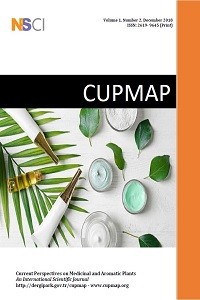Abstract
References
- 1. Baytop, T. (1999). Türkiye’de Bitkiler ile Tedavi, Geçmişte ve Bugün (2. Baskı). İstanbul: Nobel Tıp Kitabevleri.
- 2. T.C. Ekonomi Bakanlığı. (2016). Kozmetik Sektörü Raporu.
- 3. T.C. Ekonomi Bakanlığı. (2012). Kozmetik Sektörü Gelişim Çalıştayı 2015-2023 Hedefler-Stratejiler Sonuç Raporu. 13-14 Ekim 2012, Bodrum.
- 4. Arct, J. Bielenda, B. Oborska, A. Pytkowska, K. (2003). The tea and its cosmetic application. J. Appl.Cosmetol.,21, 117-127.
- 5. Joshi, L.S: Pawar, H.A. (2015). Herbal cosmetics and cosmeceuticals: An Overview. Nat. Prod. Chem. Res., 3 (2),1-8.
- 6. Sumit, K. Vivek, S. Sujata, S. Ashish, B. (2012). Herbal cosmetics: Used for skin and hair. Inventi Rapid: Cosmeceuticals, 2012 (4), 1-7.
- 7. Arıca, D.A. Selçuk, L.B. Aran, T. Ateş, E. Yaylı, S. Bahadır, S. (2017). Gebelikte kozmetik ve kişisel bakım ürünü kullanımı. Turk J. Dermatol., 11, 22-27.
- 8. Council of Europe (2002). Plants in Cosmetics Volume I. Council of Europe Publishing, Germany.
- 9. Council of Europe (2001). Plants in Cosmetics Volume II. Council of Europe Publishing, Germany.
- 10. Council of Europe (2006). Plants in Cosmetics Volume III. Council of Europe Publishing, Germany.
Obtaining Cosmetic Raw Materials from the Natural Resources of Turkey and Getting Them to the Industry
Abstract
The flora of Turkey has a wide variety of
plant species due to its geographical location and it is composed of
approximately 12,000 taxa, of which one third is endemic. Many plants have been
used for cosmetic purposes since ancient times, especially for today, in the
cosmetic industry, the demand for natural and non-harmful sources has
increased, rather than synthetic substances. Considering these two conditions, it
is observed that there are many plants in our country and this diversity finds
a lot of space in the cosmetics industry. Due to an increasing number of
natural cosmetic products for consumers, in this paper, it is aimed to create a
source of guidance for domestic suppliers/manufacturers by utilizing the
diversity of natural resources and to increase the diversity of domestic
natural products used in the industry. Besides this, in terms of raw materials
for cosmetic products, easier, sustainable and to reach in the short term as
well as economically important plants are given in this paper. Cosmetic
products and / or raw material manufacturers will improve the quality of
cosmetic raw materials and cosmetics products that they are producing in line
with this information and thus, cosmetic raw materials and products originating
from our country will be appreciated in the world.
Keywords
References
- 1. Baytop, T. (1999). Türkiye’de Bitkiler ile Tedavi, Geçmişte ve Bugün (2. Baskı). İstanbul: Nobel Tıp Kitabevleri.
- 2. T.C. Ekonomi Bakanlığı. (2016). Kozmetik Sektörü Raporu.
- 3. T.C. Ekonomi Bakanlığı. (2012). Kozmetik Sektörü Gelişim Çalıştayı 2015-2023 Hedefler-Stratejiler Sonuç Raporu. 13-14 Ekim 2012, Bodrum.
- 4. Arct, J. Bielenda, B. Oborska, A. Pytkowska, K. (2003). The tea and its cosmetic application. J. Appl.Cosmetol.,21, 117-127.
- 5. Joshi, L.S: Pawar, H.A. (2015). Herbal cosmetics and cosmeceuticals: An Overview. Nat. Prod. Chem. Res., 3 (2),1-8.
- 6. Sumit, K. Vivek, S. Sujata, S. Ashish, B. (2012). Herbal cosmetics: Used for skin and hair. Inventi Rapid: Cosmeceuticals, 2012 (4), 1-7.
- 7. Arıca, D.A. Selçuk, L.B. Aran, T. Ateş, E. Yaylı, S. Bahadır, S. (2017). Gebelikte kozmetik ve kişisel bakım ürünü kullanımı. Turk J. Dermatol., 11, 22-27.
- 8. Council of Europe (2002). Plants in Cosmetics Volume I. Council of Europe Publishing, Germany.
- 9. Council of Europe (2001). Plants in Cosmetics Volume II. Council of Europe Publishing, Germany.
- 10. Council of Europe (2006). Plants in Cosmetics Volume III. Council of Europe Publishing, Germany.
Details
| Primary Language | English |
|---|---|
| Journal Section | Research Articles |
| Authors | |
| Publication Date | December 31, 2018 |
| Published in Issue | Year 2018 Volume: 1 Issue: 2 |
-------------------------------------------------------------------------------------------------------------------------------













-------------------------------------------------------------------------------------------------------------------------
 CUPMAP Journal is licensed under a Creative Commons Attribution-NonCommercial-NoDerivatives 4.0 International License.
CUPMAP Journal is licensed under a Creative Commons Attribution-NonCommercial-NoDerivatives 4.0 International License.
-----------------------------------------------------------------------------------------------------------------------------------------
This is an open access journal which means that all content is freely available without charge to the user or his/her institution. Users are allowed to read, download, copy, distribute, print, search, or link to the full texts of the articles, or use them for any other lawful purpose, without asking prior permission from the publisher or the author. This is in accordance with the BOAI definition of open access.


